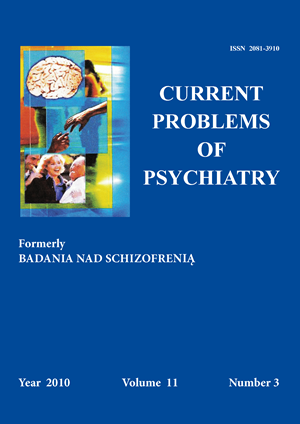Przyczyny pozostawania w relacjach opartych na przemocyPrzegląd piśmiennictwa
Słowa kluczowe:
przemoc domowa, przemoc w bliskich związkachAbstrakt
Dane z literatury wskazują, że w ciągu swojego dorosłego życia co trzecia lub co druga kobieta doświadcza przemocy ze strony intymnego partnera. Od wielu lat badacze tego zjawiska próbują odpowiedzieć na pytania: Dlaczego tak się dzieje? Dlaczego ofiary przemocy nadal pozostają w krzywdzącym je związku? Dlaczego osoby doświadczające przemocy nie potrafią zakończyć takiego związku? Niestety nie ma jednoznacznych odpowiedzi na te pytania. W literaturze przedmiotu, jako źródło przemocy jak i przyczyny pozostawania w relacjach opartych na przemocy wskazuje się zarówno na strukturę społeczną jak i na złożony zestaw wartości, tradycji, zwyczajów, tendencji i przekonań związanych z rolą płci jakie kultywuje większość kultur.
Bibliografia
1. Krauss H.H., Krauss B.J. Domestic violence and its prevention. W: Adler L.L, Denmark F.L. red., Violence and prevention of violence. Westport, CT; Praeger: 1995, s. 129-144.
2. World Health Organization. World report of violence and health. Brussels; 2002.
3. Stanko E.A., Crisp D., Hale C., Lucraft H. Counting the Costs: Estimating the Impact of Domestic Violence in the London Borough of Hackney. Wiltshire; Crime Concern: 1998.
4. Dominy N., Radford L. Domestic violence in surrey: developing an effective interagency response. London; Roehamptom Institute: 1996.
5. Field C., Caetano R. Intimate partner violence in US general population: progress and future directions. J Interpers. Violence, 2005; 20(4): 463-469.
6. Ernst A., Nick T., Weiss S., Houry D., Mills T. Domestic violence in an innercity ED. Ann. Emer. Med. 1997; 30(2): 190-197.
7. Bauer H., Rodriguez M., Pèrez-Stable R. Prevalence and determinants of intimate partner abuse among public hospital primary care patients. J. Gen. Intern. Med., 2000; 15: 811-817.
8. Abbott J., Johnson R., Koziol-McLain J., Lowenstein S.R. Domestic violence against women. Incidence and prevalence in an emergency department population. JAMA, 1995; 273:1763.
9. Coker A.L., Smith P.H., Bethea L., King M.R., McKeown R.E. Physical health consequences of physical and psycholog-ical intimate violence. Arch. Fam. Med., 2000; 9: 451.
10. Plichta S.B., Falik M. Prevalence of violence and its implications for women’s health. Womens Health Issues, 2001; 11: 244.
11. Lipowska-Teutsch A.: Przemoc wobec kobiet. W: Kubacka-Jasiecka D. i Lipowska-Teutsch A. red., Wobec przemocy. Kraków; 1997, s. 20.
12. Bandura A. Psychological mechanisms of aggression. W: Geen R.G. Donnerstein E.I. red., Aggression: Theoretical and empirical reviews. New York; Academic Press: 1983, s. 1-40.
13. Walker L.E. Survivor Therapy: Clinical Assessment and Intervention Workbook. Denver; Endolar Communications: 1993.
14. Herman L.J. Przemoc. Uraz psychiczny i powrót do równowagi. Gdańsk; Gdańskie Wydawnictwo Psychologiczne: 2004, s. 101.
15. Swann W.B., Griffin J.J., Predmore S.C., Gaines B. The cognitive affective crossfire: When self-consistency confronts self-enhancement. J. Pers. Soc. Psychol., 1987; 52: 881-889.
16. Browne A. When battered women kill. New York; Free Press: 1987.
17. Blackman J. Intimate violence. New York; Columbia University Press: 1989.
18. Sanders D.G., Size P.B. Attitudes about woman abuse victim advocates. among police officers, victims, and victim advocates. J. Interpers. Violence., 1986; 1: 25-42.
19. Walker L.E. Abused women and survivor therapy. Washington; American Psychological Association: 1994.
20. Dutton D., Painter S. Traumatic bonding: The development of emotional attachments in battered women and other relationships of intermittent abuse. Victimology An International Journal 1981; 6: 139-155.
21. Dee Graham L.R. Loving to Survive: Sexual Terror, Men`s Violence, and Women`s Lives. New York; New York University Press: 1994.


